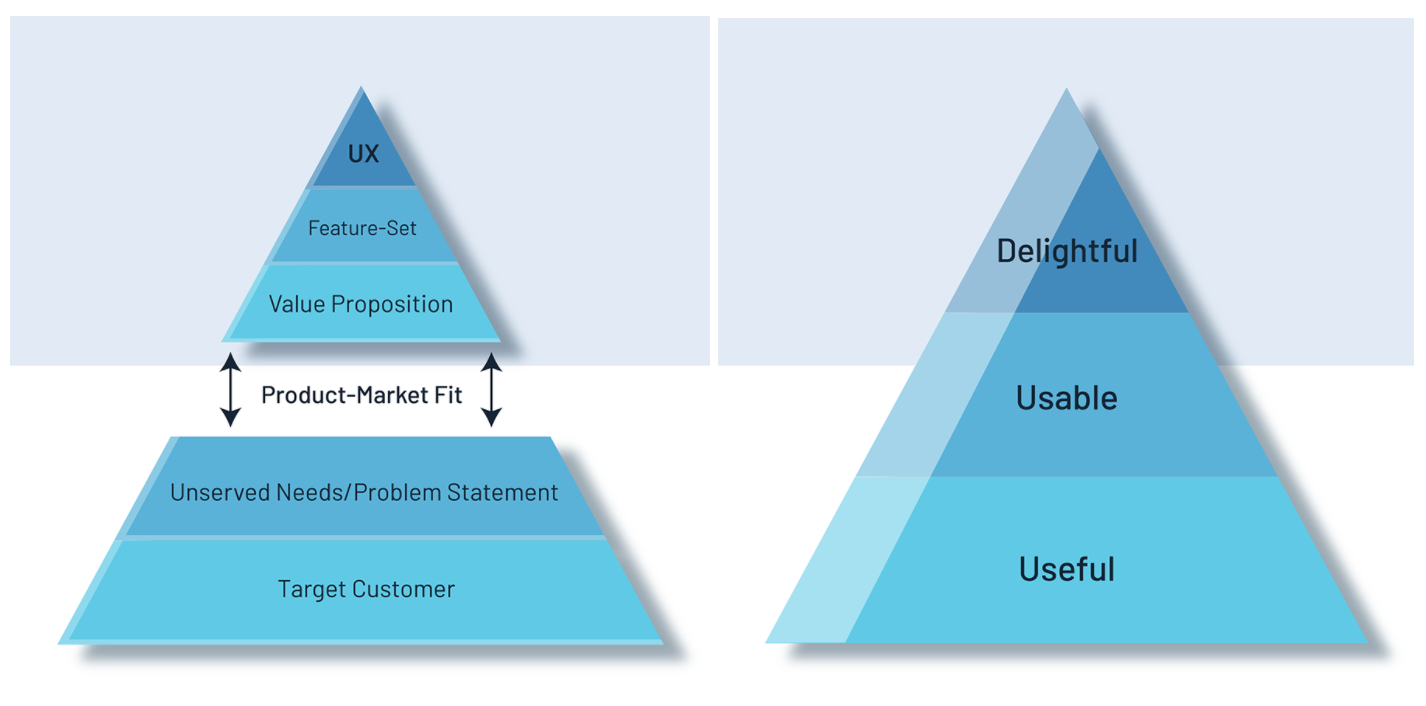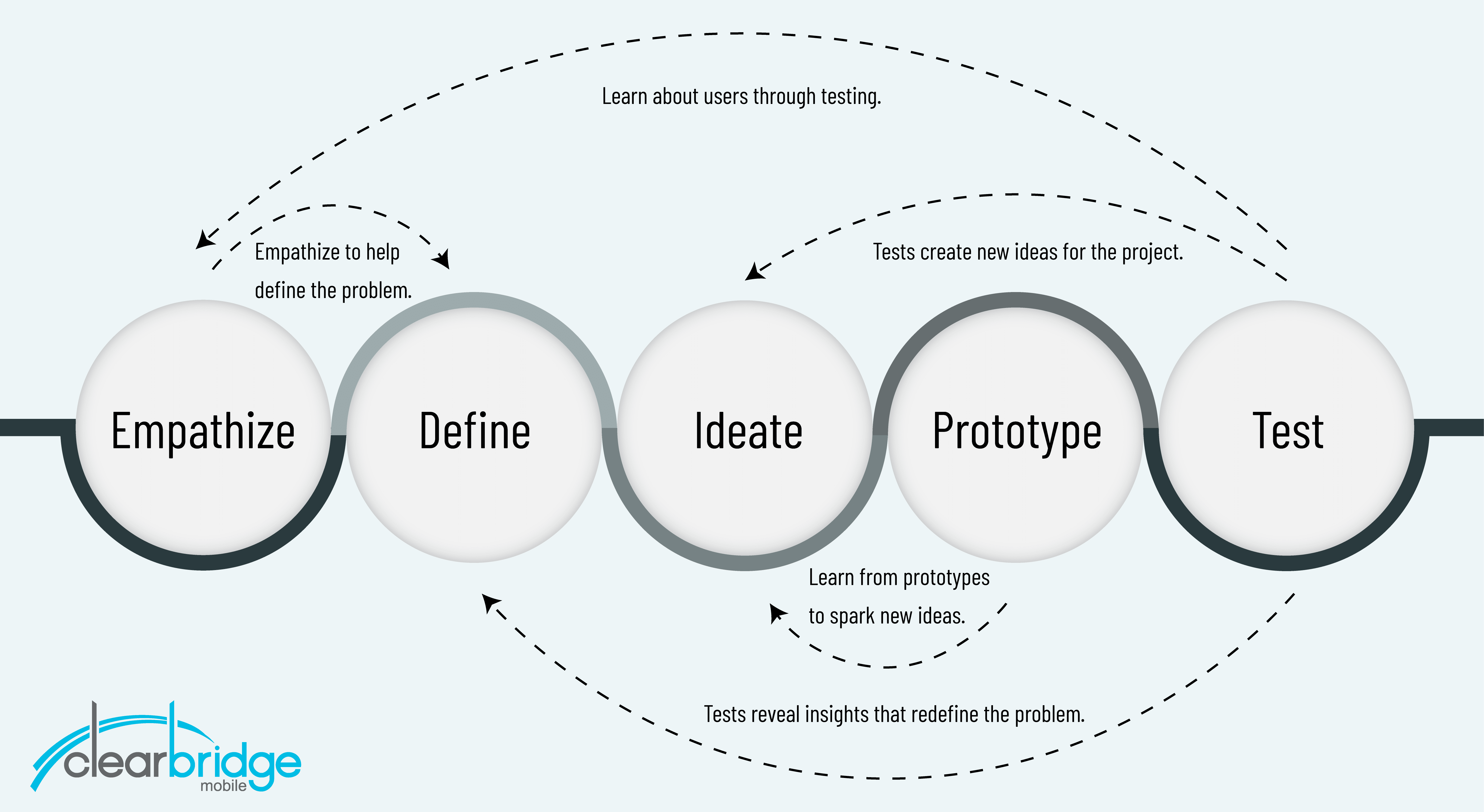Until recently, it was somewhat forgivable for businesses to underestimate the importance of flawless user experience (UX) in mobile app development. Not anymore. Customer acquisition, retention, and satisfaction don’t stand a chance against poor user experience.
People are incredibly selective about mobile applications. If an app is going to gain prime real estate on someone’s phone, it has to earn it. In other words, delivering errorless digital services is mandatory for businesses. UX design needs to be a central priority in every stage of developing a minimum viable product (MVP) to avoid frustrating customers. This is true even if you already have a product and it simply needs an update.
Developing an Effective MVP
The scope of an MVP can be very subjective based on business needs, industry, competition, product purpose, your existing product, and audience segments. Regardless, today’s most successful mobile products all began as a stripped-down version of the mature applications they are today. What’s more, an MVP is an important way to update existing applications and improve any digital offering. An MVP provides immediate value, quickly, while minimizing development costs and revealing the most suitable direction for further development.
Viability is the principle concept in an MVP. An MVP product, though small, must be able to work successfully. To be specific, an MVP needs to be useful, usable, and delightful. Customers search for valuable mobile services that are intuitive to use and fulfill a purpose in their life. But performance determines first impressions. While an MVP is a condensed product addressing a small subset of customer challenges within the context of a broader business strategy, its functionality and UX design are still critical for gaining and retaining users.
The Importance of User Experience
UX is the intuitive, empathetic, and human-centric approach to managing a person’s interaction with technology. UX involves everything that impacts a person’s perceptions, interactions, and feelings before, during, and after their interaction with a digital product or service.
In today’s society, digital experiences, particularly mobile experiences, are entirely ingrained in day-to-day activities; so much so, people are often unaware of how small the gap is between their digital and real-world actions. Digital services are officially an extension of subconscious human behavior. The statistics on the matter from AppDynamics’ 2021 App Attention Index survey are compelling:
- 85% of consumer respondents say applications and digital services have become a critical part of how they go about their lives.
- 83% of respondents say the availability of digital services has made some activities more accessible and easier to fit around other commitments.
- 83% of people report having encountered problems with applications and digital services in the past 12 months and are now far more likely to take action when they do.
This massive cultural and societal shift towards mobile preference has set high expectations for how people relate, transact, and have conversations with businesses. As a result, companies need to reevaluate existing approaches to customer experience, which is now a mobile-driven relationship.
The Impact of Poor UX
The 2021 App Attention Index survey proves that the quality, performance, and personalization of a company’s mobile services drive most buying decisions. What’s more, in the face of performance and usability issues, people experience stress, frustration, anger, and anxiety. Specifically, the number of consumers likely to switch to an alternative app when they encounter problems has risen to 96%. These types of reactions are disastrous for companies, mainly because 93% will go on to tell others about their negative experience. Customers are unforgiving and are becoming increasingly inflexible when they encounter mobile app problems.
Despite these deterring and unnerving statistics, companies can’t ignore mobile business channels. Reaping the benefits of mobile app development starts with devoted research into a mobile product’s end-user. That means understanding how they think, what they like, what they hate, what they find valuable, and, more importantly – why. Effectively learning about customers requires a different way of thinking: a way of thinking that reframes complex business problems from the customer’s perspective to identify what’s important to them. For this reason, the design thinking process is hugely beneficial for helping businesses create a customer experience that consistently generates new business value.
What is Design Thinking?
Design thinking is an iterative approach to problem-solving that helps businesses continuously reposition and think critically about business problems in human-centric ways. Design thinking encourages companies to think differently about business goals and whether or not they’re attainable. More importantly, design thinking prompts business stakeholders to analyze their business strategy and how it will translate into a product strategy. Practicing design thinking also offers many strategic advantages and deliverables. The entire process creates innovative solutions to prototype and test. It also helps companies set product goals, understand business outcomes, map out user journeys, prioritize MVP features, and create a future-oriented product roadmap.
The Five Stages of Design Thinking
The design thinking process covers five phases: empathize, define, ideate, prototype, test. The framework is iterative, flexible, and involves the collaboration of product teams and actual customers to create mobile products inspired by how users think, feel, and act.
1. The Empathize Stage
Building customer empathy involves a deep understanding of the problems and realities of the people you are designing for.
Good UX design leaves a lasting impression. Many companies struggle to develop an MVP that evokes meaning and forms a connection with customers. What’s more, many products in the market are aesthetically pleasing and usable, but still lack purpose. It’s essential to determine what impression the product is leaving with its users. This distinction is the difference between an app that customers return to and one they uninstall. Empathizing with customers is essential for creating this connection. As much as possible, business stakeholders need to step outside their frame of reference and understand the customer to develop a mobile solution that stands out in the market. This is true for both future applications and existing products.
Building customer empathy is the first stage in the design thinking process. IDEO’s Human-Centered Design Toolkit defines empathy in design thinking as a deep understanding of the problems and realities of the people you are designing for. The empathy stage involves learning about customer challenges and discovering their unexpressed needs to explain their digital behavior better. That means observing and engaging with the people the product is intended for and experiencing their physical environment. If you’re redeveloping an existing app, you probably already have mounds of user data. It’s time to reevaluate that information.
Through empathy, product teams can share a similar perspective to the customer. Empathy also helps product teams think above and beyond their assumptions and recognize that different people have individual needs and expectations. By practicing empathy and adopting the perspective of the end-user, product teams can extrapolate user needs more accurately.
2. The Define Stage
The second stage of the design thinking process focuses on defining a relevant and actionable problem statement. This guides the strategic design direction of the project. Problem statements require product teams to compound all user research findings from the empathize stage in the design thinking process.
Concerning developing an MVP, the product should focus on a single or limited set of the problems customers experience. Honing in on a small set of problems will help establish a concentrated problem statement. This approach enables the product team to set specific success criteria and clear objectives for the next stage of the design thinking process: Ideation.
Problem Statement
An appropriate problem statement needs to be:
- Customer-centric. Problem statements are written entirely from the customer’s frame of reference. A good problem statement is based on factual insights from user research. Problem statements do not focus on technical requirements, monetary returns, or feature-sets; instead, problem statements involve understanding a challenge customers are facing.
- General enough for creativity. A problem statement can’t be restrictive. The problem definition stage is meant to encourage innovation and allow product teams to explore several creative solutions to the problem.
- Precise enough to be manageable. It’s essential to balance creative freedom and practicality. If a problem statement is too general, the task can become intimidating. Problem statements need to be concise enough for the project to be manageable.
Empathy mapping is a common tactic for creating a problem definition. An empathy map has four quadrants that represent four essential traits that the customers demonstrated, expressed, or possessed during observational research. These four quadrants reference what customers say, do, think, and feel. Documenting what customers said and did is straightforward; however, understanding what customers thought and felt requires meticulous observation and adequate experience. It’s necessary to pay close attention to subtle behaviors, body language, tone of voice, suggestions, and conversations from observational studies to collect the information to complete an empathy map. With an empathy map, product teams can better understand unexpressed or indirect reactions to a product’s design, which helps create intuitive experiences beyond a customer’s expectations.
Problem definition is collecting and organizing customer research data from the empathize stage to accurately interpret the challenges customers face when using the product and their emotional reactions to the UX design.
3. The Ideation Stage
The ideation stage in design thinking is when product teams throw ideas around. The goal is to produce as many ideas as possible and inspire new ways of thinking. From there, the team can narrow the list down to the most realistic, high-quality, and innovative ideas.
During ideation, the net is cast wide to get past the apparent methods for solving customer problems and invent more refined, logical, and satisfying solutions to the challenges impacting the customer’s impression of the product. Overall, ideation helps product teams:
- Ask the right questions and innovate
- Create quantity and variety in potential solutions
- Identify solutions that are not immediately apparent
- Combine multiple perspectives, strengths, and experiences in a team setting
It’s crucial to encourage unrestricted free thinking during ideation. The purpose is to aim for quantity before tapering the list to find quality. What has worked in the past? What isn’t working for your existing applications? Now is the time for out-of-the-box brainstorming.
4. The Prototyping Stage
Prototyping allows enough time to make changes to critical design issues before the product reaches development, and it becomes too late (and too expensive) to make major changes to the UX.
Mobile app prototyping is another form of user research used to validate a product’s strategic design direction. A prototype is a preliminary visualization of a working product. In mobile app development, prototypes build an understanding of the product’s look and feel. This, in turn, helps test how customers use and react to the overall UX design. Using a prototype for usability testing allows for enough time to make changes to critical design issues before the product reaches development, and it becomes too late (and too expensive) to make major changes to the UX.
1:10:100 Rule
Consider the image above; if you only start testing on an “almost-finished” product, you risk finding serious issues too late to make changes. Prototype research is the mitigator – you’ll spend less if you do upfront research. The closer you get to launch, the more expensive changes are. Conduct prototyping research early and iteratively to ensure the design is easy and enjoyable to use, as well as to align all strategic design decisions to user needs and safeguard the project’s ROI.
The mobile app prototyping stage helps product teams learn how users interact with the “rough draft” of a product to uncover new solutions or determine whether the existing solution is successful. What is learned from a prototype allow the product team to reframe one or several of the problems identified from the previous design thinking stages. As a result, everyone on the project has a more accurate understanding of the challenges users face when using the product in the context of their life.
Mobile app prototypes take abstract ideas and turn them into a tangible product. The whole process forces product teams to slow down and think about the product from different perspectives. Tim Brown, CEO of IDEO, explains that prototypes “slow us down to speed us up. By taking the time to prototype our ideas, we avoid costly mistakes such as becoming too complex too early and sticking with a weak idea for too long.”
5. The Testing Stage
To develop successful mobile products, the testing stage in design thinking should be happening throughout the entire process. With that said, a majority of testing coincides with the prototyping stage. In the design thinking process, testing involves collecting user feedback from the product prototype. If done correctly, testing feeds into every step of design thinking. Testing helps to:
- Continue to empathize with customers.
- Produce insights that reframe the definition of the problem statement.
- Perpetuate ideation.
- Identify new ways to prototype the solution.
By the testing stage, the entire design thinking process comes full circle. Design thinking is fundamentally a cyclical activity where product teams continually review and refine the product concept, returning to the beginning of the process several times until the concept meets business objectives and customer needs. Overall, the process helps identify and fix problems early on in the project when it’s far less expensive to make changes.
Collaboration is Key for Developing an MVP
Delivering a high-quality user experience with design thinking is in no way a linear process. The development cycle involves so many connected moving parts that in the absence of collaboration, the final product could fall short of ROI expectations. Adopting a collaborative approach to developing an MVP with design thinking is easily the most effective way to ensure the final product meets customer deutsche porno needs.
The first step is to break down any departmental silos that can negatively impact the chances of building a seamless user experience into the product. An open flow of knowledge and frequent communication is crucial for setting goals and mapping the user journey towards those goals. Collectively, a team has more knowledge, experience, and insight than an individual.
The goal is not entirely about building or updating a piece of software; rather, it should be geared towards delivering a solution to customers. In return, those customers will view the product as an essential component of their daily lives. To provide a genuinely useful application, insight from those who build apps is vital; application developers have the best understanding of the potential that software holds. At the same time, developers must have a 360-degree understanding of what the customer is trying to achieve. Product owners, developers, designers, and architects who understand the entire customer journey can better frame the product to meet customer needs. A shared understanding allows every stakeholder to identify hiccups in the user experience before the product reaches completion, and can hash out solutions to problems that affect every moving part within the cycle
The Verdict on Developing an MVP with Design Thinking
More than ever, it is imperative to think critically about an MVP’s UX design and all the ways it can make a positive impression on customers. Design thinking is essential for transforming a product vision into actual deliverables. The entire process goes a long way towards delivering a product that is truly meaningful to customers. As a result, the final xxx product will address relevant pain points and provides an experience that retains long-term customers.
Keep Reading:
How to Prioritize Features for Your Mobile App MVP
Finding Opportunity in The App Market: Identifying User Pain Points
Finding Opportunity in the App Market: Competitor Research










